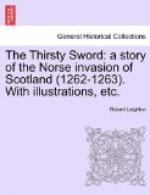Not long was Allan Redmain in following, and in the space of another hour they had carried Kenric on board the Kraken of Bute.
For six long days and nights no food had passed his lips, and had it not been that his frame was of uncommon strength he must have died in that noisome cell. For many days afterwards his mind wandered, his eyes stared blankly, his voice failed him, and not until two weeks after his rescue, when he was back again in the castle of Rothesay, did he recognize anyone.
Allan Redmain’s two galleys were but a few miles outward from the coast of Coll when they fell in with the four galleys of Bute that Kenric and Duncan had left. They had been pursued about the seas by the ships of Sweyn of Colonsay, but having outdistanced him they were now returning to the island to search for their lost leader. Either alive or dead, he must, they said, be found. Had it not been for Duncan Graham, who alone, of all men, knew where Kenric was imprisoned, all search for him must have been fruitless. On some day long after he might have been discovered, as Allan had found the starved and forgotten prisoner in that dungeon, a grim and unrecognizable skeleton.
CHAPTER XXI. HOW KENRIC MADE HIMSELF STRONG.
This expedition against the island kings had been attended with small enough success. Many of the islands had indeed been invaded and some of the smaller ones conquered. Several of the kings, wavering between service of two masters, had quietly yielded to the persuasions of King Alexander’s ambassadors. But it must be said that, despite their seeming compliance, they were ready to turn the other way again with equal ease, or even to evade their duties to either monarch and assume the dignity of independent rulers. In a political sense the result of the expedition was a failure, the conquests being incomplete, and the compliance of the less warlike kings being of the very shortest duration.
The misfortunes that had attended Kenric of Bute and Sir Piers de Currie were due almost entirely to the bad work of the wild men of Galloway, whose lust for slaughter and pillage, whose wanton plunderings of churches and slaying of women and children brought down upon the Scots the hatred of the Norsemen in whose lands these depredations had been made.
It was not long ere the word had travelled far and wide among the Western Isles that the barbarities committed by the Gallwegians were the work of young Kenric of Bute. It was said that Kenric of Bute alone had ordered the massacre of the children of Colonsay. It was said that he had wantonly ordered similar atrocities in Jura, in Barra, and indeed in all those isles which the unruly men of Galloway had invaded. Upon Kenric and his people, therefore, the sons of the vikings swore deadly vengeance, calling upon their patron saint to aid them.
The Norsemen of the Western Isles lost little time in sending messengers to Norway, telling how the King of Scots had attempted to force their allegiance to his crown.




